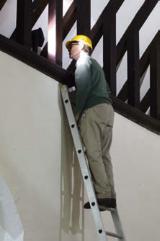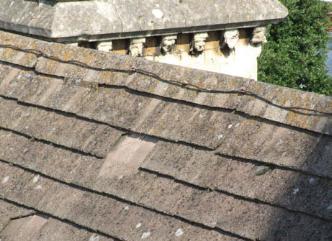

BCD Special Report on
Historic Churches
17th annual edition
15
and that the system needs to be reviewed.
But for now let us concentrate on the broad
issues of the inspection process, and how it
can best be used to beneft the parishes.
Appointing a QI consultant
Every DAC secretary will be familiar with
the plaintive phone call from a parish ofcer
asking how one sets about appointing a
new QI consultant. In the next few seconds
one tries to remember who their current
one is, who the personalities in the parish
are and what might have gone wrong
with the professional relationship.
To help the appointment process some
DACs provide guidance notes for parishioners.
Gloucester DAC’s guidance, for example,
is aimed at helping to manage expectations
and to prompt the people responsible for the
selection to ask appropriate questions. It will
usually pay dividends for parishes if they take
the appointment process quite seriously. Often
the best thing is for two or three members of
the PCC to meet a small shortlist of possible
candidates. It may be helpful to telephone other
parishes for which each candidate has worked.
It is probably better for the selectors
to meet the candidates in their ofces than
at the church: you can learn a lot from the
style of the practice and the resources at
its disposal. How will your church work
ft in with the sort of projects which the
practice normally undertakes? You can
take some photographs and a plan of the
church so as to have something to discuss.
It’s very important at that meeting to ask
about fee structures. Te QI fees are usually laid
down in advance, but the PCC needs to be quite
clear about fees for subsequent repair work and,
even more importantly, for general advice.
The relationship with
the QI consultant
One of the great missed opportunities in the
care of churches feld is that PCCs tend to use
their QI consultant every fve years for the
quinquennial (when they have to), and as little
as possible in between. It has been suggested
many times that ideally the relationship ought
to be rather like that with the family doctor – in
other words somebody to consult whenever
one is in doubt about anything. Although well
meant, this analogy is rather naive, because
by and large we do not have to pay to go and
see our doctor. Many PCCs are frightened
even to speak to their QI consultant, in case
the imaginary taximeter starts to whirl.
You therefore need to ask a prospective
candidate: ‘What is your attitude to charging
for casual advice?’ Te fact is that most church
QI consultants are very happy to be consulted
informally and will not charge unless and
until they need to make a special journey to
the church or to produce written work such
as an instruction for the builder. Te wise
churchwarden or fabric ofcer will therefore not
hesitate to make a call, which may well set his
mind at rest or may result in an ofer such as:
‘I will be passing the church next Wednesday.
Shall we meet there and have a quick look at it?’
At this stage there will normally be no fee, but
for the health of the professional relationship,
the PCC does need to be very clear what
constitutes fee paying work and how much
the bill will be when that stage is reached.
Sadly, many of the difculties which crop
up between PCCs and their QI consultants
are due to a failure on both sides to look each
other in the eye and discuss what professional
services will cost. PCCs for their part need to
understand that a professional practice cannot
run on thin air and that time-consuming work
needs to be paid for. Te QI consultant also
needs to acknowledge that formal professional
work such as preparation of a specifcation
will be inordinately expensive if the work in
question is very minor. More of that later.
Preparing for the QI
Let us now assume that the date for the
next quinquennial survey has been set.
How should the PCC prepare, so that
the best use is made of the time?
Many QI consultants will set out in
a standard letter quite clearly what they
need, which essentially boils down to safe
access to as many parts of the building as
possible. Te QI consultant cannot report on
conditions if there is a locked door preventing
access. Make sure therefore that every key is
available, including boiler room and tower.
Te next stage is to think about high-level
access, other than the tower top, which is
usually straightforward. One of the questions
to ask at the selection interview is whether
the QI consultant is content to use ladders
– always provided that these are safely fxed.
Te answer should be an unequivocal and
cheerful ‘yes’. Depending on the physical
characteristics of your church, it may sufce
to bring in a competent local builder with
good ladders. In some cases, the parish may
have suitable ladders available, but make sure
that the QI consultant is going to be happy
using them and that sufcient able-bodied
people are available to get the ladders into a
safe position and to hold the bottom safely.
For some churches, the only way to get
up to high level parts is with a cherry picker.
Tis will add considerably to the cost of the
exercise, but it may be money well spent.
What is the point of paying £500 for the
quinquennial if the fndings are prejudiced
by the inability to get a close up view? It may
cost an additional £300 to bring in a cherry
picker, but this could dramatically enhance
the value obtained from the report.
Furthermore, the cherry picker can be
used in other ways, for example to clear gutters
or to change light bulbs, as part of the same
operation. Loose pieces of masonry can be
brought down for safety using the cherry picker.
But if you are planning to do this, make sure
that the QI consultant is aware that he or she is
expected to go aloft. If you are hiring a cherry
Toby Falconer examines the wall plate
Photograph taken from a cherry picker at St Peter’s, Cheltenham: this kind of access can give an invaluable
close-up view of roof defects